Megaclasts: Term Use and Relevant Biases †
Abstract
:1. Introduction
2. Conceptual Remarks on Megaclasts
3. Material and Method
4. Basic Trends of Megaclast Research
5. Geological Spatio-Temporal Dimension of the Term Application
6. Discussion
7. Conclusions
Author Contributions
Funding
Acknowledgments
Conflicts of Interest
References
- Blair, T.C.; McPherson, J.G. Grain-size and textural classification of coarse sedimentary particles. J. Sediment. Res. 1999, 69, 6–19. [Google Scholar] [CrossRef]
- Farrell, K.M.; Harris, W.B.; Mallinson, D.J.; Culver, S.J.; Riggs, S.R.; Pierson, J.; Self-Trail, J.M.; Lautier, J.C. Standardizing texture and facies codes for a process-based classification of clastic sediment and rock. J. Sediment. Res. 2012, 82, 364–378. [Google Scholar] [CrossRef]
- Lokier, S.W.; Al Junaibi, M. The petrographic description of carbonate facies: Are we all speaking the same language? Sedimentology 2016, 63, 1843–1885. [Google Scholar] [CrossRef]
- Udden, J.A. The Mechanical Composition of Wind Deposits. Augustana Lib. Publ. 1898, 1, 1–69. [Google Scholar]
- Wentworth, C.K. A scale of grade and class terms for clastic sediments. J. Geol. 1922, 30, 377–392. [Google Scholar] [CrossRef]
- Ruban, D.A. Research in tsunami-related sedimentology during 2001–2010: Can a single natural disaster re-shape the science? GeoActa 2011, 10, 79–85. [Google Scholar]
- Wimbledon, W.A.P.; Smith-Meyer, S. (Eds.) Geoheritage in Europe and Its Conservation; ProGEO: Oslo, Norway, 2012; pp. 1–405. [Google Scholar]
- Lubova, K.A.; Zayats, P.P.; Ruban, D.A.; Tiess, G. Megaclasts in geoconservation: Sedimentological questions, anthropogenic influence, and geotourism potential. Geologos 2013, 19, 321–335. [Google Scholar] [CrossRef]
- Pajola, M.; Vincent, J.-B.; Guttler, C.; Lee, J.-C.; Bertini, I.; Massironi, M.; Simioni, E.; Marzari, F.; Giacomini, L.; Lucchetti, A.; et al. Size-frequency distribution of boulders ≥7 m on comet 67P/Churyumov-Gerasimenko. Astron. Astrophys. 2015, 583, A37. [Google Scholar] [CrossRef]
- Bruno, D.E.; Ruban, D.A. Something more than boulders: A geological comment on the nomenclature of megaclasts on extraterrestrial bodies. Planet. Space Sci. 2017, 135, 37–42. [Google Scholar] [CrossRef]
- Dhingra, D.; Head, J.W.; Pieters, C.M. Geological mapping of impact melt deposits at lunar complex craters Jackson and Tycho: Morphologic and topographic diversity and relation to the cratering process. Icarus 2017, 283, 268–281. [Google Scholar] [CrossRef]
- Blair, T.C.; McPherson, J.G. Processes and forms of alluvial fans. In Geomorphology of Desert Environments; Parsons, A.J., Abrahams, A.D., Eds.; Springer: Dordrecht, The Netherlands, 2009; pp. 413–467. [Google Scholar]
- Blott, S.J.; Pye, K. Particle size scales and classification of sediment types based on particle size distributions: Review and recommended procedures. Sedimentology 2012, 59, 2071–2096. [Google Scholar] [CrossRef]
- Terry, J.P.; Goff, J. Megaclasts: Proposed revised nomenclature at the coarse end of the Udden-Wentworth grain-size scale for sedimentary particles. J. Sediment. Res. 2014, 84, 192–197. [Google Scholar] [CrossRef]
- Dow, D.B. Evidence of a Late Pre-Cambrian Glaciation in the Kimberley Region of Western Australia. Geol. Mag. 1965, 102, 407–414. [Google Scholar] [CrossRef]
- Swift, D.J.P.; Heron, S.D., Jr. Tidal deposits in the cretaceous of the Carolina coastal plain. Sediment. Geol. 1967, 1, 259–282. [Google Scholar] [CrossRef]
- Stauffer, P.H.; Snelling, N.J. A Precambrian trondhjemite boulder in Palaeozoic mudstones of NW Malaya. Geol. Mag. 1977, 114, 479–482. [Google Scholar] [CrossRef]
- Diffendal, R.F., Jr. Megaclasts in alluvial fills from the Ogallala Group (Miocene), Banner, Kimball, and Morrill counties, Nebraska. Contrib. Geol. Univ. Wyo. Laram. 1983, 22, 109–115. [Google Scholar]
- Postma, G.; Nemec, W.; Kleinspehn, K.L. Large floating clasts in turbidites: A mechanism for their emplacement. Sediment. Geol. 1988, 58, 47–61. [Google Scholar] [CrossRef]
- Heubeck, C. Sedimentology of large olistoliths, southern Cordillera Central, Hispaniola. J. Sediment. Petrol. 1992, 62, 474–482. [Google Scholar]
- Kirillova, K.; Fu, X.; Lehto, X.; Cai, L. What makes a destination beautiful? Dimensions of tourist aesthetic judgment. Tour. Manag. 2014, 42, 282–293. [Google Scholar] [CrossRef]
- Qiu, H.-H.; Liu, L.-G. A Study on the Evolution of Carbon Capture and Storage Technology Based on Knowledge Mapping. Energies 2018, 11, 1103. [Google Scholar] [CrossRef]
- Paris, R.; Naylor, R.A.; Stephenbson, W.J. Boulders as signatures of storms on rock coasts. Mar. Geol. 2011, 283, 1–11. [Google Scholar] [CrossRef]
- Paris, R.; Ramalho, R.S.; Madeira, J.; Avila, S.; May, S.M.; Rixhon, G.; Engel, M.; Bruckner, H.; Herzog, M.; Schukraft, G.; et al. Mega-tsunami conglomerates and flank collapses of ocean island volcanoes. Mar. Geol. 2018, 395, 168–187. [Google Scholar] [CrossRef]
- Ramalho, R.S.; Winckler, G.; Madeira, G.; Helffrich, G.R.; Hipolito, A.; Quartau, R.; Adena, K.; Schaefer, J.M. Hazard potential of volcanic flank collapses raised by new megatsunami evidence. Sci. Adv. 2015, 1, e1500456. [Google Scholar] [CrossRef] [PubMed] [Green Version]
- Hearty, P.J.; Tormey, B.R. Sea-level change and superstorms; geologic evidence from the last interglacial (MIS 5e) in the Bahamas and Bermuda offers ominous prospects for a warming Earth. Mar. Geol. 2017, 390, 347–365. [Google Scholar] [CrossRef]
- Cox, R.; Jahn, K.J.; Watkins, O.G.; Cox, P. Extraordinary boulder transport by storm waves (west of Ireland, winter 2013–2014), and criteria for analysing coastal boulder deposits. Earth-Sci. Rev. 2018, 177, 623–636. [Google Scholar] [CrossRef]
- Barbano, M.S.; Pirrotta, C.; Gerardi, F. Large boulders along the south-eastern Ionian coast of Sicily: Storm or tsunami deposits? Mar. Geol. 2010, 275, 140–154. [Google Scholar] [CrossRef]
- Canto, A.P.B.; Padrones, J.T.; Concepcion, R.A.B.; Perez, A.D.C.; Tamayo, R.A.; Dimalanta, C.B.; Faustino-Eslava, D.V.; Queano, K.L.; Yumul, G.P. Geology of northwestern Mindoro and its offshore islands: Implications for terrane accretion in west Central Philippines. J. Asian Earth. Sci. 2012, 61, 78–87. [Google Scholar] [CrossRef]
- Carpentier, C.; Lathuiliere, B.; Ferry, S. The Oxfordian carbonate platform of Lorraine: Evidences for an opening toward the Germanic Sea. Comptes Rendus Geosci. 2004, 336, 59–66. [Google Scholar] [CrossRef]
- Choe, M.Y.; Sohn, Y.K.; Jo, H.R.; Kim, Y. Sedimentary facies and evolution of the Cretaceous deep-sea channel system in Magallanes Basin, southern Chile. Ocean Polar Res. 2004, 26, 385–400. [Google Scholar] [CrossRef]
- Coira, B.; Perez, B. Peperitic textures of Ordovician dacitic synsedimentary intrusions in Argentina’s Puna Highland: Clues to emplacement conditions. J. Volcanol. Geotherm. Res. 2002, 114, 165–180. [Google Scholar] [CrossRef]
- Dewey, J.F.; Ryan, P.D. Storm, rogue wave, or tsunami origin for megaclast deposits in western Ireland and North Island, New Zealand? Proc. Natl. Acad. Sci. USA 2017, 114, E10639–E10647. [Google Scholar] [CrossRef] [PubMed]
- Engel, M.; May, S.M. Bonaire’s boulder fields revisited: Evidence for Holocene tsunami impact on the Leeward Antilles. Quat. Sci. Rev. 2012, 54, 126–141. [Google Scholar] [CrossRef]
- Furlanetto, F.; Thorkelson, D.J.; Daniel Gibson, H.; Marshall, D.D.; Rainbird, R.H.; Davis, W.J.; Crowley, J.L.; Vervoort, J.D. Late Paleoproterozoic terrane accretion in northwestern Canada and the case for circum-Columbian orogenesis. Precambrian Res. 2013, 224, 512–528. [Google Scholar] [CrossRef]
- Gaylord, D.R.; Neall, V.E. Subedifice collapse of an andesitic stratovolcano: The maitahi formation, Taranaki Peninsula, New Zealand. Bull. Geol. Soc. Am. 2012, 124, 181–199. [Google Scholar] [CrossRef]
- Gaylord, D.R.; Neall, V.E.; Palmer, A.S. The middle Pleistocene Maitahi Formation, Taranaki, New Zealand: A new formal lithostratigraphic unit. N. Z. J. Geol. Geophys. 2014, 57, 369–377. [Google Scholar] [CrossRef]
- Goff, J.; Terry, J.P. Tsunamigenic slope failures: The Pacific Islands ‘blind spot’? Landslides 2016, 13, 1535–1543. [Google Scholar] [CrossRef]
- Hall, A.M.; Hansom, J.D.; Williams, D.M. Wave-emplaced coarse debris and megaclasts in Ireland and Scotland: Boulder transport in a high-energy littoral environment: A discussion. J. Geol. 2010, 118, 699–704. [Google Scholar] [CrossRef]
- Hoffmann, G.; Reicherter, K.; Wiatr, T.; Grutzner, C.; Rausch, T. Block and boulder accumulations along the coastline between Fins and Sur (Sultanate of Oman): Tsunamigenic remains? Nat. Hazards 2013, 65, 851–873. [Google Scholar] [CrossRef]
- Horak, J.M.; Evans, J.A. Early Neoproterozoic limestones from the Gwna Group, Anglesey. Geol. Mag. 2011, 148, 78–88. [Google Scholar] [CrossRef]
- Jackson, C.A.-L. Three-dimensional seismic analysis of megaclast deformation within a mass transport deposit; Implications for debris flow kinematics. Geology 2011, 39, 203–206. [Google Scholar] [CrossRef]
- Kalnina, L.; Strautnieks, I.; Cerina, A. Upper Pleistocene biostratigraphy and traces of glaciotectonics at the Satiki site, western Latvia. Quat. Int. 2007, 164–165, 197–206. [Google Scholar] [CrossRef]
- Keigler, R.; Thouret, J.-C.; Hodgson, K.A.; Neall, V.E.; Lecointre, J.A.; Procter, J.N.; Cronin, S.J. The Whangaehu Formation: Debris-avalanche and lahar deposits from ancestral Ruapehu volcano, New Zealand. Geomorphology 2011, 133, 57–79. [Google Scholar] [CrossRef]
- Laird, M.G.; Bassett, K.N.; Schioler, P.; Morgans, H.E.G.; Bradshaw, J.D.; Weaver, S.D. Paleoenvironmental and tectonic changes across the Cretaceous/Tertiary boundary at Tora, southeast Wairarapa, New Zealand: A link between Marlborough and Hawke’s Bay. N. Z. J. Geol. Geophys. 2003, 46, 275–293. [Google Scholar] [CrossRef]
- Laughton, J.R.; Thorkelson, D.J.; Brideau, M.-A.; Hunt, J.A.; Marshall, D.D. Early Proterozoic orogeny and exhumation of Wernecke Supergroup revealed by vent facies of Wernecke Breccia, Yukon, Canada. Can. J. Earth Sci. 2005, 42, 1033–1044. [Google Scholar] [CrossRef]
- Le Heron, D.P.; Busfield, M.E.; Prave, A.R. Neoproterozoic ice sheets and olistoliths: Multiple glacial cycles in the Kingston Peak Formation, California. J. Geol. Soc. 2014, 171, 525–538. [Google Scholar] [CrossRef]
- Le Heron, D.P.; Tofaif, S.; Vandyk, T.; Ali, D.O. A diamictite dichotomy: Glacial conveyor belts and olistostromes in the Neoproterozoic of Death Valley, California, USA. Geology 2017, 45, 31–34. [Google Scholar] [CrossRef]
- Le Roux, J.P. A critical examination of evidence used to re-interpret the hornitos mega-breccia as a mass-flow deposit caused by cliff failure. Andean Geol. 2015, 42, 139–145. [Google Scholar]
- Le Roux, J.P.; Vargas, G. Hydraulic behavior of tsunami backflows: Insights from their modern and ancient deposits. Environ. Geol. 2005, 49, 65–75. [Google Scholar] [CrossRef]
- Lecointre, J.A.; Neall, V.E.; Wallace, C.R.; Prebble, W.M. The 55- to 60-ka Te Whaiau Formation: A catastrophic, avalanche-induced, cohesive debris-flow deposit from Proto-Tongariro volcano, New Zealand. Bull. Volcanol. 2002, 63, 509–525. [Google Scholar] [CrossRef]
- Lorang, M.S. A wave-competence approach to distinguish between boulder and megaclast deposits due to storm waves versus tsunamis. Mar. Geol. 2011, 283, 90–97. [Google Scholar] [CrossRef]
- Madon, M. Submarine mass-transport deposits in the Semantan Formation (Middle-Upper Triassic), central Peninsular Malaysia. Bull. Geol. Soc. Malays. 2010, 56, 15–26. [Google Scholar]
- Martin-Merino, G.; Fernandez, L.P.; Colmenero, J.R.; Bahamonde, J.R. Mass-transport deposits in a Variscan wedge-top foreland basin (Pisuerga area, Cantabrian Zone, NW Spain). Mar. Geol. 2014, 356, 71–87. [Google Scholar] [CrossRef]
- McKee, J.W.; McKee, M.B.; Anderson, T.H. Mesozoic basin formation, mass-gravity sedimentation, and inversion in northeastern Sonora and southeastern Arizona. Spec. Pap. Geol. Soc. Am. 2005, 393, 481–507. [Google Scholar] [CrossRef]
- Medina, F.; Mhammdi, N.; Chiguer, A.; Akil, M.; Jaaidi, E.B. The Rabat and Larache boulder fields; new examples of high-energy deposits related to storms and tsunami waves in north-western Morocco. Nat. Hazards 2011, 59, 725–747. [Google Scholar] [CrossRef]
- Noormets, R.; Felton, E.A.; Crook, K.A.W. Sedimentology of rocky shorelines: 2 Shoreline megaclasts on the north shore of Oahu, Hawaii—Origins and history. Sediment. Geol. 2002, 150, 31–45. [Google Scholar] [CrossRef]
- Noormets, R.; Crook, K.A.W.; Felton, E.A. Sedimentology of rocky shorelines: 3. Hydrodynamics of megaclast emplacement and transport on a shore platform, Oahu, Hawaii. Sediment. Geol. 2004, 172, 41–65. [Google Scholar] [CrossRef]
- Oliveira, M.A.; Andrade, C.; Freitas, M.C.; Costa, P.; Taborda, R.; Janardo, C.; Neves, R. Transport of large boulders quarried from shore platforms of the Portuguese west coast. J. Coast. Res. 2011, 64, 1871–1875. [Google Scholar]
- Ortiz-Karpf, A.; Hodgson, D.M.; McCaffrey, W.D. The role of mass-transport complexes in controlling channel avulsion and the subsequent sediment dispersal patterns on an active margin: The Magdalena Fan, offshore Colombia. Mar. Petrol. Geol. 2015, 64, 58–75l. [Google Scholar] [CrossRef]
- Paris, R.; Kelfoun, K.; Giachetti, T. Marine conglomerate and reef megaclasts at Mauritus island: Evidences of a tsunami generated by a flank collapse of the Piton de la Fournaise volcano, Reunion Island? Sci. Tsunami Hazards 2013, 32, 281–291. [Google Scholar]
- Perez-Alberti, A.; Trenhaile, A.S.; Pires, A.; Lopez-Bedoya, J.; Chamine, H.I.; Gomes, A. The effect of boulders on shore platform development and morphology in Galicia, north west Spain. Cont. Shelf Res. 2012, 48, 122–137. [Google Scholar] [CrossRef]
- Pierre, G. Processes and rate of retreat of the clay and sandstone sea cliffs of the northern Boulonnais (France). Geomorphology 2006, 73, 64–77. [Google Scholar] [CrossRef]
- Pope, M.C.; Grotzinger, J.P. Paleoproterozoic Stark Formation, Athapuscow Basin, northwest Canada: Record of cratonic-scale salinity crisis. J. Sediment. Res. 2003, 73, 280–295. [Google Scholar] [CrossRef]
- Preiss, W.V.; Gostin, V.A.; McKirdy, D.M.; Ashley, P.M.; Williams, G.E.; Schmidt, P.W. The glacial succession of Sturtian age in South Australia: The Yudnamutana Subgroup. Geo. Soc. Mem. 2011, 36, 701–712. [Google Scholar] [CrossRef]
- Roverato, M.; Cronin, S.; Procter, J.; Capra, L. Textural features as indicators of debris avalanche transport and emplacement, Taranaki volcano. Bull. Geol. Soc. Am. 2015, 127, 3–18. [Google Scholar] [CrossRef]
- Salisbury, J.A.; Tomkins, A.G.; Schaefer, B.F. New insights into the size and timing of the Lawn Hill impact structure: Relationship to the Century Zn–Pb deposit. Aust. J. Earth Sci. 2008, 55, 587–603. [Google Scholar] [CrossRef]
- Scheffers, S.R.; Scheffers, A.; Kelletat, D.; Bryant, E.A. The Holocene paleo-tsunami history of West Australia. Earth Planet. Sci. Lett. 2008, 270, 137–146. [Google Scholar] [CrossRef] [Green Version]
- Scheffers, A.; Scheffers, S.; Kelletat, D.; Browne, T. Wave-emplaced coarse debris and megaclasts in Ireland and Scotland: Boulder transport in a high-energy littoral environment. J. Geol. 2009, 117, 553–573. [Google Scholar] [CrossRef]
- Scheffers, A.; Kelletat, D.; Scheffers, S. Wave-emplaced coarse debris and megaclasts in Ireland and Scotland: Boulder transport in a high-energy littoral environment: A reply. J. Geol. 2010, 118, 705–709. [Google Scholar] [CrossRef]
- Shane, P.; Strachan, L.J.; Smith, I. Redefining the Waitemata Basin, New Zealand: A new tectonic, magmatic, and basin evolution model at a subduction terminus in the SW Pacific. Geochem. Geophys. Geosyst. 2010, 11, Q04008. [Google Scholar] [CrossRef]
- Suttner, T.J.; Kido, E. Distinct sea-level fluctuations and deposition of a megaclast horizon in the neritic Rauchkofel Limestone (Wolayer area, Carnic Alps) correlate with the Lochkov-Prag Event. Geol. Soc. Lond. Spec. Publ. 2016, 423, 11–23. [Google Scholar] [CrossRef]
- Thorkelson, D.J.; Laughton, J.R. Paleoproterozoic closure of an Australia-Laurentia seaway revealed by megaclasts of an obducted volcanic arc in Yukon, Canada. Gondwana Res. 2016, 33, 115–133. [Google Scholar] [CrossRef]
- Trenhaile, A. Rocky coasts—Their role as depositional environments. Earth-Sci. Rev. 2016, 159, 1–13. [Google Scholar] [CrossRef]
- Weckwerth, P.; Pisarska-Jamrozy, M. Periglacial and fluvial factors controlling the sedimentation of Pleistocene breccia in NW Poland. Geogr. Ann. Ser. A Phys. Geogr. 2015, 97, 415–430. [Google Scholar] [CrossRef]
- Williams, D.M. Mechanisms of wave transport of megaclasts on elevated cliff-top platforms: Examples from western Ireland relevant to the storm-wave versus tsunami controversy. Ir. J. Earth Sci. 2010, 28, 13–23. [Google Scholar] [CrossRef]
- Williams, D.M.; Hall, A.M. Cliff-top megaclast deposits of Ireland, a record of extreme waves in the North Atlantic—Storms or tsunamis? Mar. Geol. 2004, 206, 101–117. [Google Scholar] [CrossRef]
- Yagishita, K.; Komori, K. Basin evolution within the Kitakami Massif, northeast Japan: Relationship between sedimentation, tectonics and volcanism in an incipient Neogene continental back-arc basin. Sediment. Geol. 2000, 133, 7–26. [Google Scholar] [CrossRef]
- Rovere, A.; Casella, E.; Harris, D.L.; Lorscheid, T.; Nandasena, N.A.K.; Dyer, B.; Sandstrom, M.R.; Stocchi, P.; D’Andrea, W.J.; Raymo, M.E. Giant boulders and Last Interglacial storm intensity in the North Atlantic. Proc. Natl. Acad. Sci. USA 2017, 114, 12144–12149. [Google Scholar] [CrossRef] [Green Version]
- Ogg, J.G.; Ogg, G.M.; Gradstein, F.M. A Concise Geologic Time Scale 2016; Elsevier: Amsterdam, The Netherlands, 2016; pp. 1–234. [Google Scholar]
- Johnson, M.E. Why are ancient rocky shores so uncommon? J. Geol. 1988, 96, 469–480. [Google Scholar] [CrossRef]
- Johnson, M.E. Uniformitarianism as a guide to rocky-shore ecosystems in the geological record. Can. J. Earth Sci. 2006, 43, 1119–1147. [Google Scholar] [CrossRef]
- Habibi, T.; Golubova, N.V.; Ruban, D.A. New evidence of highly-complex geological heritage in Iran: Miocene sections in the Zagros Fold-Thrust Belt. GeoResJ 2017, 13, 96–102. [Google Scholar] [CrossRef]
- Sallam, E.S.; Ponedelnik, A.A.; Tiess, G.; Yashalova, N.N.; Ruban, D.A. The geological heritage of the Kurkur-Dungul area in southern Egypt. J. Afr. Earth Sci. 2018, 137, 103–115. [Google Scholar] [CrossRef]
- Sallam, E.S.; Fathy, E.E.; Ruban, D.A.; Ponedelnik, A.A.; Yashalova, N.N. Geological heritage diversity in the Faiyum Oasis (Egypt): A comprehensive assessment. J. Afr. Earth Sci. 2018, 140, 212–224. [Google Scholar] [CrossRef]
- Panek, T.; Lenart, J.; Hradecky, J.; Hercman, H.; Braucher, R.; Silhan, K.; Skarpich, V. Coastal cliffs, rock-slope failures and Late Quaternary transgressions of the Black Sea along southern Crimea. Quat. Sci. Rev. 2018, 181, 76–92. [Google Scholar] [CrossRef]
- Dott, R.H., Jr.; Byers, C.W. Cambrian geology of the Baraboo Hills. Field Guide 2016, 43, 47–54. [Google Scholar] [CrossRef]
- Johnson, M.E.; Ledesma-Vazques, J.; Backus, D.H. Tectonic Decapitation of a Pliocene Mega-Delta on Isla Del Carmen in the Gulf of California (Mexico): And a River Ran through it. J. Geol. 2016, 124, 55–74. [Google Scholar] [CrossRef]
- Soukopova, J. Central Saharan rock art: Considering the kettles and cupules. J. Arid Environ. 2017, 143, 10–14. [Google Scholar] [CrossRef]
- Soukopova, J. Decorated boulders and other neglected features of the Central Saharan rock art. J. Arid Environ. 2018, 156, 96–105. [Google Scholar] [CrossRef]
- Erdmann, W.; Kelletat, D.; Scheffers, A. Boulder transport by storms—Extreme-waves in the coastal zone of the Irish west coast. Mar. Geol. 2018, 399, 1–13. [Google Scholar] [CrossRef]
- Hongo, C.; Kurihara, H.; Golbuu, Y. Coral boulders on Melekeok reef in the Palau Islands: An indicator of wave activity associated with tropical cyclones. Mar. Geol. 2018, 399, 14–22. [Google Scholar] [CrossRef]
- Johnson, M.E.; Ledesma-Vazquez, J.; Guardado-France, R. Coastal Geomorphology of a Holocene Hurricane Deposit on a Pleistocene Marine Terrace from Isla Carmen (Baja California Sur, Mexico). J. Mar. Sci. Eng. 2018, 6, 108. [Google Scholar] [CrossRef]
- Lau, A.Y.A.; Terry, J.P.; Ziegler, A.; Pratap, A.; Harris, D. Boulder emplacement and remobilisation by cyclone and submarine landslide tsunami waves near Suva City, Fiji. Sediment. Geol. 2018, 364, 242–257. [Google Scholar] [CrossRef]
- Spatola, D.; Micallef, A.; Sulli, A.; Basilone, L.; Ferreri, R.; Basilone, G.; Bonanno, A.; Pulizzi, M.; Mangano, S. The Graham Bank (Sicily Channel, central Mediterranean Sea): Seafloor signatures of volcanic and tectonic controls. Geomorphology 2018, 318, 375–389. [Google Scholar] [CrossRef]
- Basilone, L. Mesozoic tectono-sedimentary evolution of Rocca Busambra in western Sicily. Facies 2009, 55, 115–135. [Google Scholar] [CrossRef]
- Basilone, L.; Di Maggio, C. Geology of Monte Gallo (Palermo Mts, NW Sicily). J. Maps 2016, 12, 1072–1083. [Google Scholar] [CrossRef] [Green Version]
- Basilone, L.; Frixa, A.; Trincianti, E.; Valenti, V. Permian-Cenozoic deep-water carbonate rocks of the Southern Tethyan Domain. The case of Central Sicily. Ital. J. Geosci. 2016, 135, 171–198. [Google Scholar] [CrossRef] [Green Version]
- Jones, W.T.; Feldmann, R.M.; Schweitzer, C.E.; Reitano, A.; Insacco, G. New Pygocephalomorph (Peracarida) from the Permian of the Sosio Valley (Sicily, Italy). J. Crustac. Biol. 2015, 35, 627–632. [Google Scholar] [CrossRef]
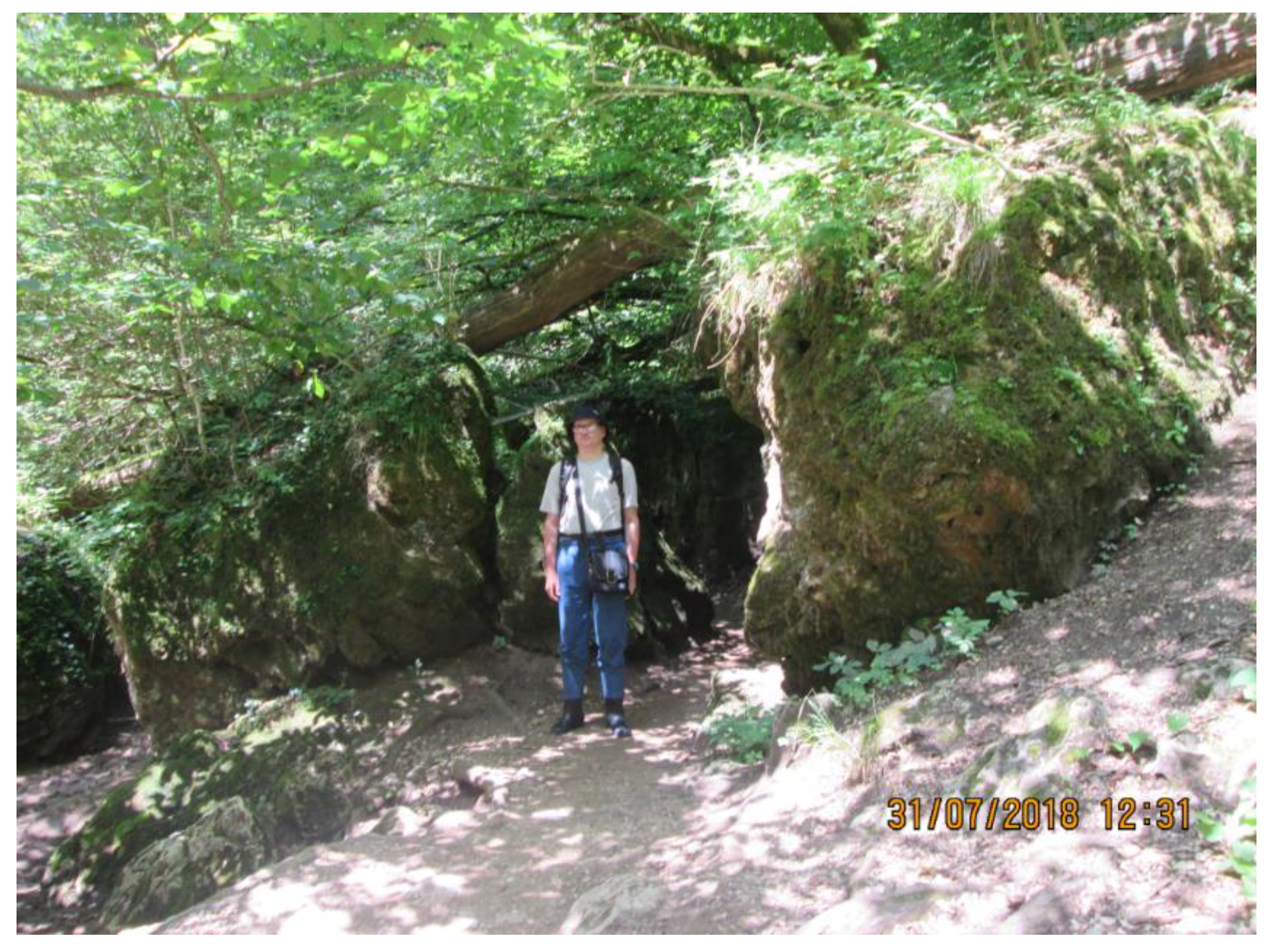
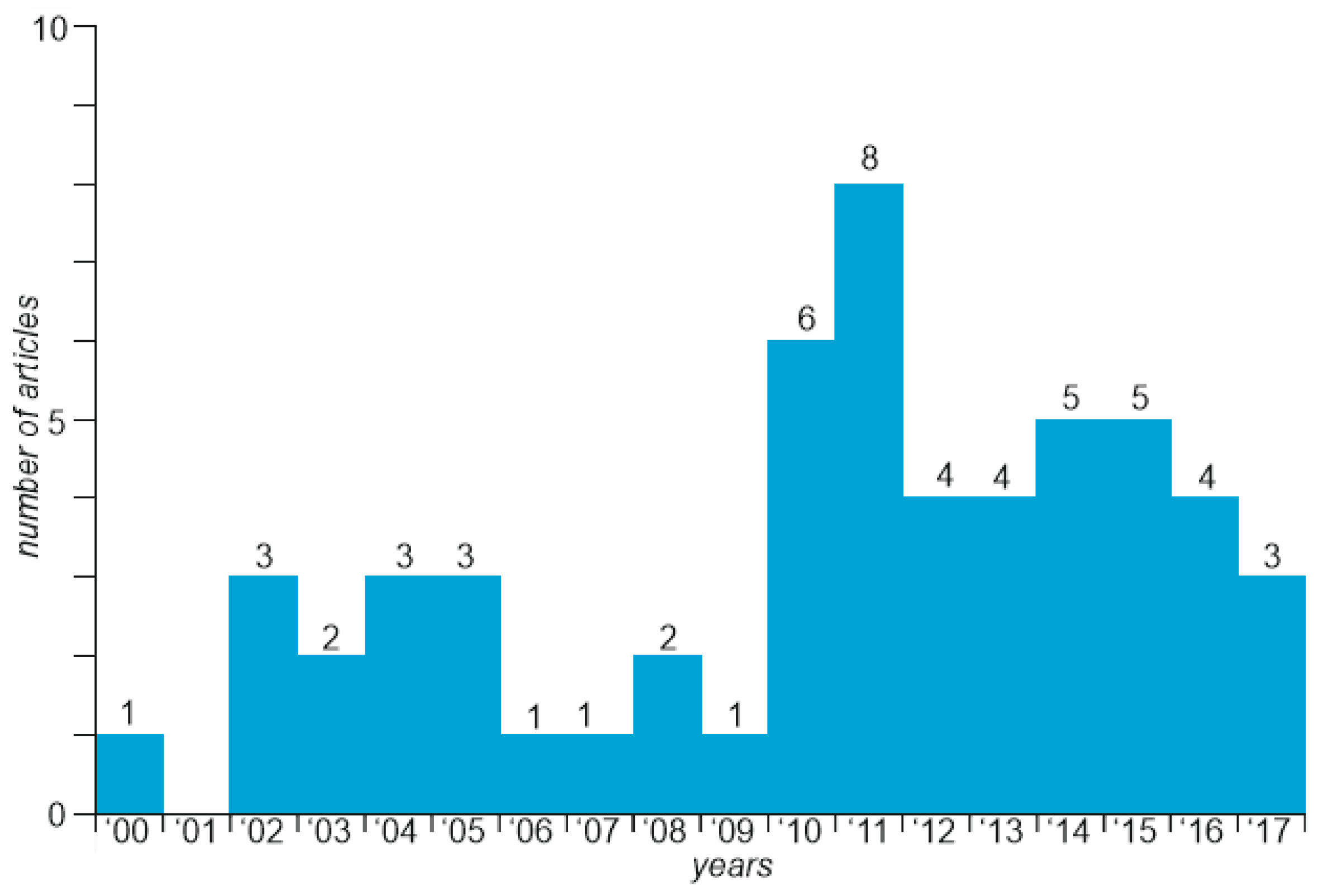
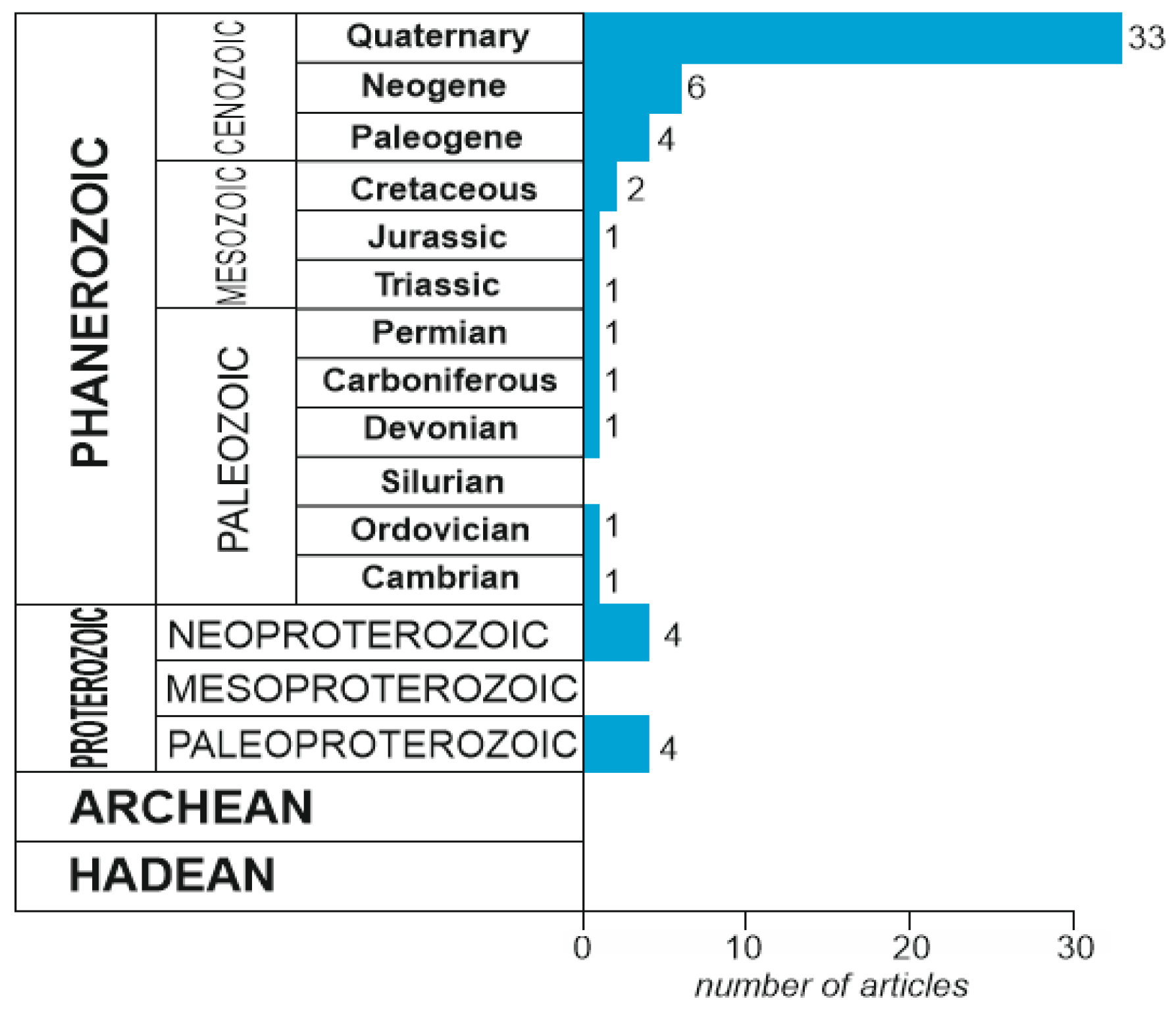

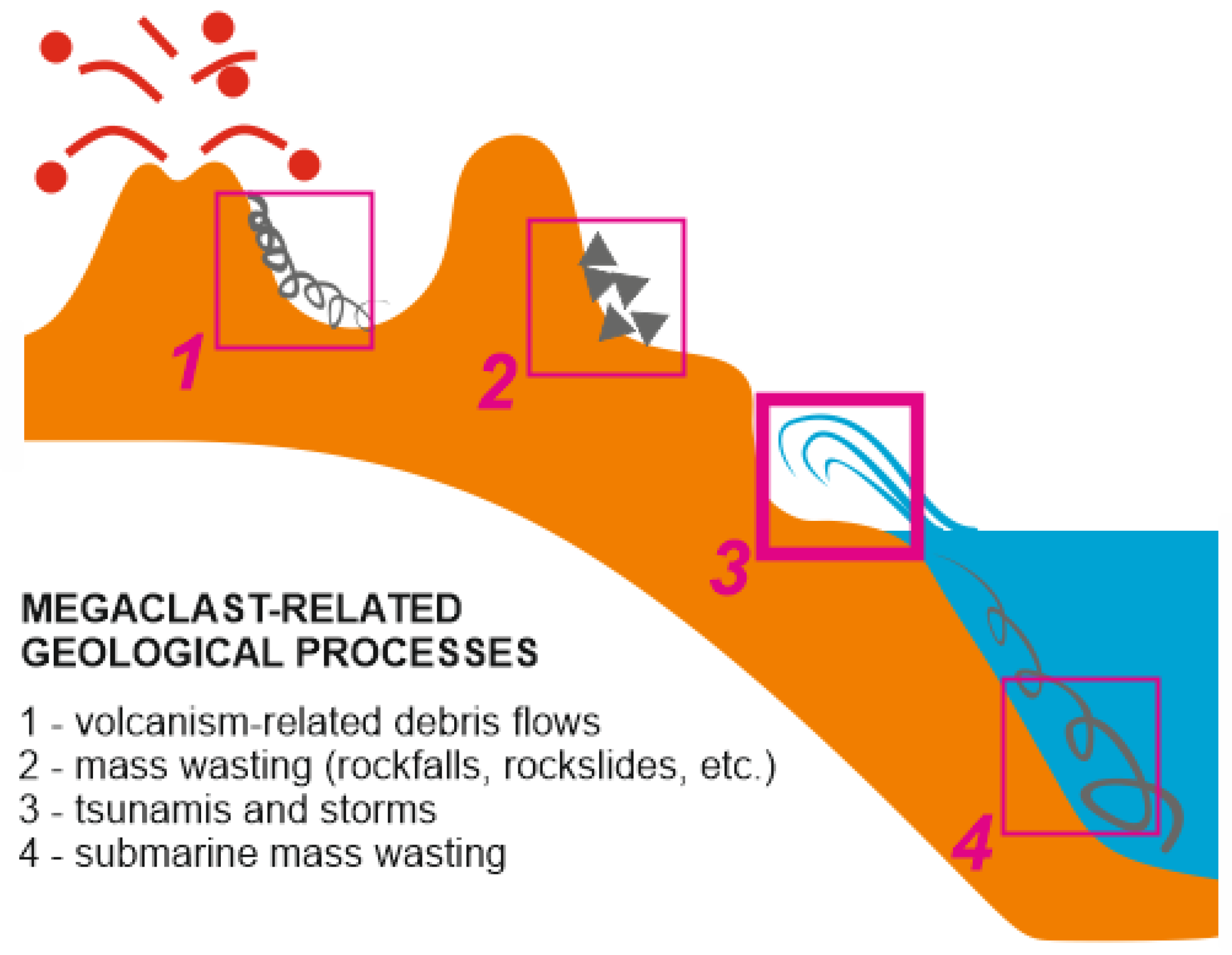
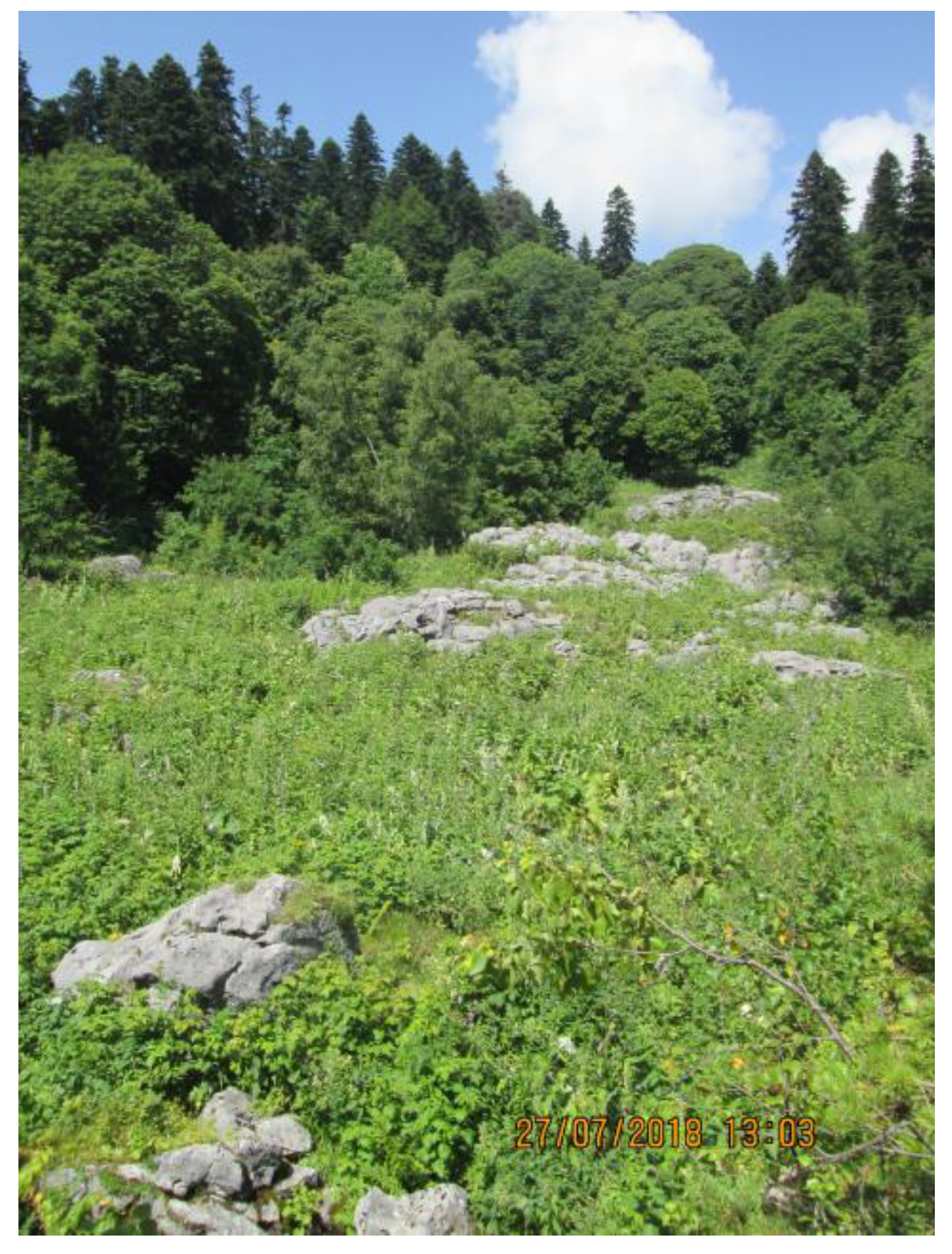

| Author(s), Source | Age | Location | Facies/Origin |
|---|---|---|---|
| Barbano et al. [28] | Q | Sicily | Tsunami |
| Bruno and Ruban [10] | - | extraterrestrial bodies | Extraterrestial |
| Canto et al. [29] | Pg | Philippines | Tectonic |
| Carpentier et al. [30] | J | France | Storm |
| Choe et al. [31] | K | Chile | Deep-marine channel |
| Coira and Perez [32] | O | Argentina | Magma-water interaction |
| Dewey and Ryan [33] | N, Q | New Zealand | Tsunami, storm |
| Engel and May [34] | Q | Caribbean | Tsunami |
| Furlanetto et al. [35] | PPR | northwestern Canada | Tectonic |
| Gaylord and Neall [36] | Q | New Zealand | Volcanic |
| Gaylord et al. [37] | Q | New Zealand | Volcanic |
| Goff and Terry [38] | Q | Pacific | Tsunami |
| Hall et al. [39] | Q | British Isles | Coast |
| Hoffmann et al. [40] | Q | Arabia | Tsunami |
| Horak and Evans [41] | NPR | British Isles | - |
| Jackson [42] | CZ | offshore Brazil | Submarine mass wasting |
| Kalnina et al. [43] | Q | Baltic Region | Glacial erosion |
| Keigler et al. [44] | Q | New Zealand | Volcanic and mass wasting |
| Laird et al. [45] | Pg | New Zealand | Channel |
| Laughton et al. [46] | PPR | northwestern Canada | Tectonic + volcanic |
| Le Heron et al. [47] | NPR | western United States | Tectonic and ice-rafting |
| Le Heron et al. [48] | NPR | western United States | Tectonic |
| Le Roux [49] | CZ | Chile | Mass wasting and tsunami |
| Le Roux and Vargas [50] | N | Chile | Mass wasting and tsunami |
| Lecointre et al. [51] | Q | New Zealand | Volcanic and mass wasting |
| Lorang [52] | - | - | Tsunami and storm |
| Lubova et al. [8] | Q | Caucasus | Mass wasting |
| Madon [53] | T | Malaysia | Submarine mass wasting |
| Martin-Merino et al. [54] | PZ2 | Spain | Submarine mass wasting |
| McKee et al. [55] | K | western United States | Mass wasting |
| Medina et al. [56] | Q | Morocco | Tsunami and storm |
| Noormets et al. [57] | Q | Pacific | Tsunami |
| Noormets et al. [58] | Q | Pacific | Tsunami |
| Oliveira et al. [59] | Q | Portugal | Storm |
| Ortiz-Karpf et al. [60] | Q | Caribbean | Submarine mass wasting |
| Paris et al. [61] | Q | Mauritius | Tsunami |
| Perez-Alberti et al. [62] | Q | Spain | Storm |
| Pierre [63] | Q | France | Coastal processes |
| Pope and Grotzinger [64] | PPR | northwestern Canada | Evaporite dissolution and mass wasting |
| Preiss et al. [65] | NPR | Australia | Glaciation |
| Roverato et al. [66] | Q | New Zealand | Volcanic and mass wasting |
| Salisbury et al. [67] | Cm | Australia | Extraterrestrial impact |
| Scheffers et al. [68] | Q | Australia | Tsunami |
| Scheffers et al. [69] | Q | British Isles | Storm |
| Scheffers et al. [70] | Q | British Isles | Storm |
| Shane et al. [71] | N | New Zealand | Submarine mass wasting |
| Suttner and Kido [72] | D | Alps | Coastal processes |
| Terry and Goff [14] | - | - | - |
| Thorkelson and Laughton [73] | PPR | northwestern Canada | Tectonic |
| Trenhaile [74] | - | - | Coastal processes |
| Weckwerth and Pisarska-Jamrozy [75] | Q | Poland | Fluvial-periglacial |
| Williams [76] | Q | British Isles | Storm |
| Williams and Hall [77] | Q | British Isles | Storm |
| Yagishita and Komori [78] | N | Japan | Mass wasting |
| Hearty and Tormey [26] | Q | Bahamas | Storm |
| Cox et al. [27] | Q | Ireland | Storm |
| Paris et al. [23] | - | - | Storm |
| Paris et al. [24] | Q | Cape Verde, Mauritius, Reunion | Tsunami |
| Ramalho et al. [25] | Q | Cape Verde | Tsunami, coastal processes |
| Process | Newly-Formed Megaclasts | Transported Megaclasts | |
|---|---|---|---|
| Slope failure | Rockfall, landslide | + (colluvial megaclasts) | + |
| Debris flow, submarine flow | + | ||
| Triggered by wave abrasion | + | ||
| Triggered by earthquake | + | ||
| Deep-seated gravitational slope deformation | + | + | |
| Triggered by human activity | + | ||
| Volcanism | Eruption | + | |
| Debris flow | + | ||
| Storms and tsunamis | + | ||
| Weathering | + (aeluvial megaclasts) | ||
| Extraterrestrial impact | + | ||
| Glacier activity | + (erratic megaclasts) | + | |
| Iceberg activity | + | ||
| Tectonic jointing | + | ||
| Large-scale tectonic processes | + (olistoliths, olistostromes) | ||
| Karstification (development of grikes) | + | ||
| Human activity | + (artificial megaclasts) | + | |
| Name | Location | Origin | Notes |
|---|---|---|---|
| Ehalkivi (Sunset Glow Boulder) | Viru-Nigula Parish, Lääne-Viru County, Estonia | Erratic | Height 7 m |
| Devils Marbles | Tennant Creek, Northern Territory, Australia | Erosion | Some clasts naturally balance on one another |
| Wairere Boulders | Northland Region, New Zealand | Erosion | Clasts represent remnants of the eroded basalt flow |
| Kummakivi (Strange Stone) | Ruokolahti, Finland | Erratic? | Length 7 m |
| Unnamed | Champ Island, Franz Josef Land, Russia | Weathering? | Stone spheres up to >1 m in size |
| Sosio Megablock | Silicy, Italy | Mass wasting | Permian limestones |
| Krishna’s Butterball (Vaan Irai Kal) | Mahabalipuram, Tamil Nadu, India | ? | Height 6 m, width 5 m, clasts rests on inclined slope |
© 2018 by the authors. Licensee MDPI, Basel, Switzerland. This article is an open access article distributed under the terms and conditions of the Creative Commons Attribution (CC BY) license (http://creativecommons.org/licenses/by/4.0/).
Share and Cite
Ruban, D.A.; Ponedelnik, A.A.; Yashalova, N.N. Megaclasts: Term Use and Relevant Biases. Geosciences 2019, 9, 14. https://doi.org/10.3390/geosciences9010014
Ruban DA, Ponedelnik AA, Yashalova NN. Megaclasts: Term Use and Relevant Biases. Geosciences. 2019; 9(1):14. https://doi.org/10.3390/geosciences9010014
Chicago/Turabian StyleRuban, Dmitry A., Alena A. Ponedelnik, and Natalia N. Yashalova. 2019. "Megaclasts: Term Use and Relevant Biases" Geosciences 9, no. 1: 14. https://doi.org/10.3390/geosciences9010014






